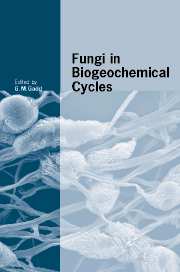Book contents
- Frontmatter
- Contents
- List of Contributors
- Preface
- 1 Geomicrobiology: relative roles of bacteria and fungi as geomicrobial agents
- 2 Integrated nutrient cycles in boreal forest ecosystems – the role of mycorrhizal fungi
- 3 Fungal roles in transport processes in soils
- 4 Water dynamics of mycorrhizas in arid soils
- 5 Integrating ectomycorrhizal fungi into quantitative frameworks of forest carbon and nitrogen cycling
- 6 Role of arbuscular mycorrhizal fungi in carbon and nutrient cycling in grassland
- 7 The role of wood decay fungi in the carbon and nitrogen dynamics of the forest floor
- 8 Relative roles of bacteria and fungi in polycyclic aromatic hydrocarbon biodegradation and bioremediation of contaminated soils
- 9 Biodegradation and biodeterioration of man-made polymeric materials
- 10 Fungal dissolution and transformation of minerals: significance for nutrient and metal mobility
- 11 Fungal activities in subaerial rock-inhabiting microbial communities
- 12 The oxalate–carbonate pathway in soil carbon storage: the role of fungi and oxalotrophic bacteria
- 13 Mineral tunnelling by fungi
- 14 Mineral dissolution by ectomycorrhizal fungi
- 15 Lichen biogeochemistry
- 16 Fungi in subterranean environments
- 17 The role of fungi in carbon and nitrogen cycles in freshwater ecosystems
- 18 Biogeochemical roles of fungi in marine and estuarine habitats
- Index
- References
7 - The role of wood decay fungi in the carbon and nitrogen dynamics of the forest floor
Published online by Cambridge University Press: 10 December 2009
- Frontmatter
- Contents
- List of Contributors
- Preface
- 1 Geomicrobiology: relative roles of bacteria and fungi as geomicrobial agents
- 2 Integrated nutrient cycles in boreal forest ecosystems – the role of mycorrhizal fungi
- 3 Fungal roles in transport processes in soils
- 4 Water dynamics of mycorrhizas in arid soils
- 5 Integrating ectomycorrhizal fungi into quantitative frameworks of forest carbon and nitrogen cycling
- 6 Role of arbuscular mycorrhizal fungi in carbon and nutrient cycling in grassland
- 7 The role of wood decay fungi in the carbon and nitrogen dynamics of the forest floor
- 8 Relative roles of bacteria and fungi in polycyclic aromatic hydrocarbon biodegradation and bioremediation of contaminated soils
- 9 Biodegradation and biodeterioration of man-made polymeric materials
- 10 Fungal dissolution and transformation of minerals: significance for nutrient and metal mobility
- 11 Fungal activities in subaerial rock-inhabiting microbial communities
- 12 The oxalate–carbonate pathway in soil carbon storage: the role of fungi and oxalotrophic bacteria
- 13 Mineral tunnelling by fungi
- 14 Mineral dissolution by ectomycorrhizal fungi
- 15 Lichen biogeochemistry
- 16 Fungi in subterranean environments
- 17 The role of fungi in carbon and nitrogen cycles in freshwater ecosystems
- 18 Biogeochemical roles of fungi in marine and estuarine habitats
- Index
- References
Summary
Introduction
The mycelium of woodland fungi can act both as a reservoir and as a distribution system for nutrients, owing to its physiological and developmental adaptations to life at the interface between organic and mineral soil horizons. The mobility of accumulated nitrogen and phosphorus within the mycelial networks of cord-forming wood decay fungi and ectomycorrhiza enables fungi to play key roles as wood decomposers and root symbionts. The dynamics of nitrogen movement have been less investigated than phosphorus owing to lack of a suitable tracer. We have developed a new technique for tracing nitrogen translocation in real time, using 14C as a marker for nitrogen by incorporating it into a non-decomposed amino acid that tracks the mycelial free amino acid pool. Its movement can be imaged by counting photon emissions from a scintillant screen in contact with the mycelial system. This method allows real-time imaging at high temporal and spatial resolution, for periods of weeks and areas up to 1 m2, in microcosms that mimic the mineral/organic soil interface of the forest floor. The results reveal a hitherto unsuspected dynamism and responsiveness in amino acid flows through mycelial networks of cord-forming, wood-decomposing basidiomycetes. We interpret these in the light of current understanding of the pivotal role of fungi in boreal and temperate forest floor nutrient cycling, and attempt to formulate key questions to investigate the effects of mycelial nitrogen translocation on forest floor decomposition and nitrogen absorption.
- Type
- Chapter
- Information
- Fungi in Biogeochemical Cycles , pp. 151 - 181Publisher: Cambridge University PressPrint publication year: 2006
References
- 42
- Cited by



